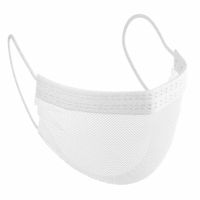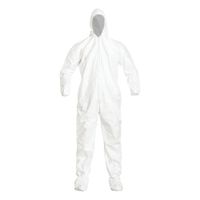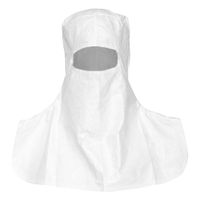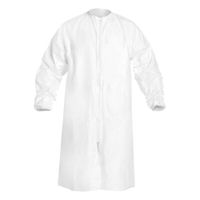Call +(254) 703 030 000 / 751 483 999 / 721 704 777
- Home
- Safety
- Protective Clothing
- Cleanroom Protective Clothing
.....Read More
Frequently Asked Questions
What materials are cleanroom protective clothing made of?
Cleanroom protective clothing is typically made from materials designed to minimize particle release and provide a barrier against contaminants. Common materials include:
1. **Polyester**: Often used in woven or non-woven forms, polyester is a synthetic fiber known for its durability and low particle shedding. It is frequently used in cleanroom garments due to its ability to resist contamination and maintain cleanliness.
2. **Polypropylene**: This is a lightweight, non-woven fabric that offers good breathability and is often used in disposable cleanroom garments. It provides a basic level of protection against particulates and is cost-effective for single-use applications.
3. **Tyvek®**: A brand of flash-spun high-density polyethylene fibers, Tyvek® is known for its excellent barrier properties against particles and microorganisms. It is lightweight, durable, and often used in disposable cleanroom suits.
4. **Gore-Tex®**: This material is used in cleanroom garments for its breathability and barrier properties. It is a membrane that allows moisture vapor to escape while preventing the ingress of liquids and particulates.
5. **Nomex®**: A flame-resistant material often used in cleanrooms where fire hazards are a concern. It provides protection against heat and flame while maintaining low particle emission.
6. **Conductive or Static-Dissipative Materials**: These materials are incorporated into cleanroom clothing to prevent static electricity buildup, which can attract particles. They often include carbon or other conductive fibers woven into the fabric.
7. **SMS (Spunbond-Meltblown-Spunbond)**: A tri-layer material that combines strength, barrier protection, and breathability. It is commonly used in disposable cleanroom garments for its balance of protection and comfort.
These materials are selected based on the specific requirements of the cleanroom environment, including the level of cleanliness, type of contaminants, and the need for durability or disposability.
How do cleanroom garments limit contamination?
Cleanroom garments are specifically designed to limit contamination by acting as a barrier between the wearer and the controlled environment. These garments are made from materials that minimize the release of particles and fibers, which are potential contaminants. The fabrics used are typically non-linting and have low particle shedding properties, ensuring that they do not contribute to the contamination load within the cleanroom.
The design of cleanroom garments is also crucial in limiting contamination. They are constructed to cover as much of the body as possible, including hoods, masks, gloves, and boots, to prevent skin flakes, hair, and other biological contaminants from entering the cleanroom environment. The garments are often made with tight seams and closures to prevent particles from escaping through openings.
Additionally, cleanroom garments are often treated with anti-static properties to prevent the attraction and retention of particles due to static electricity. This is important because static charges can attract and hold onto particles, which can then be released into the cleanroom environment.
The use of cleanroom garments is part of a broader contamination control strategy that includes proper gowning procedures. Personnel are trained to don and doff these garments in a specific sequence to minimize the risk of contamination during the process. This includes steps such as washing hands before gowning and ensuring that garments are donned in a cleanroom or gowning area to prevent contamination from external environments.
Overall, cleanroom garments are a critical component in maintaining the integrity of cleanroom environments by providing a physical barrier, reducing particle shedding, and incorporating anti-static properties, all of which help to limit contamination effectively.
What is the significance of ISO ratings for cleanroom clothing?
ISO ratings for cleanroom clothing are crucial as they define the level of cleanliness and contamination control required in various controlled environments. These ratings, particularly ISO 14644-1, classify cleanrooms based on the concentration of airborne particles, which directly impacts the type of clothing necessary to maintain the desired cleanliness level.
The significance of ISO ratings lies in their ability to standardize the requirements for cleanroom apparel across industries such as pharmaceuticals, biotechnology, electronics, and aerospace. By adhering to these standards, organizations ensure that their cleanroom clothing effectively minimizes the risk of contamination from particles, fibers, and microorganisms that can be shed by personnel.
ISO ratings guide the selection of materials and design features for cleanroom garments, such as coveralls, hoods, gloves, and footwear. Higher ISO classes (e.g., ISO Class 1-3) demand more stringent controls and specialized clothing made from non-linting, low-shedding materials with sealed seams and closures to prevent particle release. Lower ISO classes (e.g., ISO Class 7-9) may allow for less restrictive clothing, but still require garments that maintain a barrier against contamination.
By following ISO ratings, companies can ensure compliance with regulatory requirements, enhance product quality, and protect both personnel and sensitive processes. This standardization also facilitates international trade and collaboration by providing a common framework for cleanroom operations. Overall, ISO ratings for cleanroom clothing are essential for maintaining the integrity of controlled environments and ensuring the safety and efficacy of products manufactured within them.
What types of cleanroom garments provide full body coverage?
Cleanroom garments that provide full body coverage are essential in maintaining the controlled environment by minimizing contamination from particles and microorganisms. These garments are designed to cover the entire body, including the head, torso, arms, legs, and feet. The primary types of cleanroom garments that offer full body coverage include:
1. **Coveralls**: These are one-piece suits that cover the entire body from neck to ankles and wrists. They are typically made from non-linting, synthetic materials that prevent particle shedding. Coveralls often feature elastic cuffs and ankles to ensure a snug fit and minimize exposure.
2. **Hoods**: Cleanroom hoods cover the head and neck, leaving only the face exposed. They are designed to be worn with face masks and goggles to ensure complete coverage. Some hoods are integrated with coveralls for seamless protection.
3. **Boot Covers**: These are worn over regular footwear to prevent contamination from shoes. Boot covers extend up to the knees and are often made from the same material as coveralls. They may have elastic or ties to secure them in place.
4. **Face Masks**: While not a full-body garment, face masks are crucial for covering the mouth and nose, preventing the spread of respiratory particles. They are used in conjunction with other garments to ensure comprehensive coverage.
5. **Gloves**: Cleanroom gloves are worn to protect hands and prevent contamination from skin particles. They are usually made from latex, nitrile, or other synthetic materials and are designed to be worn over the sleeves of coveralls.
6. **Integrated Systems**: Some cleanroom environments require integrated garment systems that combine coveralls, hoods, and boot covers into a single piece, ensuring no gaps in coverage.
These garments are often used in conjunction with other cleanroom protocols to maintain the integrity of the controlled environment.
How do shoe and boot covers function in a cleanroom environment?
Shoe and boot covers function in a cleanroom environment by acting as a barrier to prevent contamination from entering the controlled space. They are designed to cover footwear completely, ensuring that dirt, dust, and other particulates from the outside environment do not get transferred into the cleanroom. These covers are typically made from materials like polypropylene, polyethylene, or Tyvek, which are non-shedding and resistant to liquids and particulates.
In a cleanroom, maintaining a controlled level of contamination is crucial for the integrity of processes and products, especially in industries like pharmaceuticals, biotechnology, and electronics. Shoe and boot covers help achieve this by minimizing the introduction of contaminants that can be carried on the soles and surfaces of shoes. They are often used in conjunction with other personal protective equipment (PPE) such as gowns, gloves, and masks to ensure comprehensive protection.
The covers are usually disposable, allowing for single-use to prevent cross-contamination. They are easy to put on and take off, often featuring elastic bands or ties to secure them in place. Some cleanrooms may use reusable covers that can be laundered and sterilized, depending on the level of cleanliness required.
In addition to preventing contamination, shoe and boot covers can also protect the wearer from exposure to hazardous substances present in the cleanroom. They contribute to maintaining the cleanroom's classification by ensuring that the environment remains within the specified limits of particulate and microbial contamination. Overall, shoe and boot covers are a critical component of cleanroom protocol, supporting both product quality and personnel safety.
What is the purpose of bouffants and veils in cleanrooms?
Bouffants and veils are essential components of cleanroom attire, designed to maintain the stringent cleanliness standards required in such controlled environments. Their primary purpose is to minimize contamination by containing human hair, skin particles, and other potential contaminants that individuals might inadvertently introduce into the cleanroom.
Bouffants, which are essentially hair coverings, are worn to ensure that hair strands do not shed into the cleanroom environment. Human hair can carry particles, oils, and microorganisms that could compromise the sterile conditions necessary for sensitive processes, such as semiconductor manufacturing, pharmaceutical production, or biotechnology research. By covering the hair completely, bouffants help maintain the integrity of the cleanroom by preventing these contaminants from becoming airborne.
Veils, often used in conjunction with bouffants, provide additional coverage for the face and neck area. They serve to further reduce the risk of contamination from skin flakes, saliva droplets, or other facial emissions. In cleanrooms where the highest levels of cleanliness are required, veils are crucial in ensuring that no part of the face is exposed, thereby minimizing the potential for contamination.
Together, bouffants and veils form part of a comprehensive cleanroom garment system that includes gloves, gowns, masks, and shoe covers. This system is designed to create a barrier between the individual and the cleanroom environment, ensuring that the controlled conditions necessary for high-precision and contamination-sensitive operations are maintained. By effectively containing human-derived contaminants, bouffants and veils play a critical role in upholding the cleanliness and sterility standards of cleanrooms.
How do you determine the appropriate cleanroom class for garments?
To determine the appropriate cleanroom class for garments, consider the following factors:
1. **Cleanroom Classification**: Identify the cleanroom class based on ISO 14644-1 standards or equivalent (e.g., ISO Class 1 to 9, or Federal Standard 209E Class 1 to 100,000). The class dictates the maximum allowable particle count and size.
2. **Garment Material**: Choose materials that minimize particle shedding and are compatible with the cleanroom class. Common materials include polyester, Tyvek, and other non-linting fabrics.
3. **Garment Design**: Ensure the design minimizes particle release. Features like covered zippers, elastic cuffs, and seamless construction help maintain cleanliness.
4. **Contamination Risk**: Assess the level of contamination risk associated with the cleanroom activities. Higher risk processes require stricter garment standards.
5. **Industry Standards**: Follow industry-specific guidelines (e.g., pharmaceuticals, electronics) that may have additional requirements for garment selection.
6. **Frequency of Use**: Consider how often garments will be used and laundered. Frequent use may necessitate more durable materials.
7. **Comfort and Fit**: Ensure garments are comfortable and fit well to prevent movement restrictions, which can lead to garment damage and contamination.
8. **Regulatory Compliance**: Adhere to any regulatory requirements specific to your industry or region.
9. **Supplier Certification**: Choose garments from suppliers who provide certification of compliance with cleanroom standards.
10. **Testing and Validation**: Conduct regular testing and validation of garments to ensure they meet the required cleanroom standards over time.
By evaluating these factors, you can select garments that maintain the integrity of the cleanroom environment and comply with the necessary standards.




